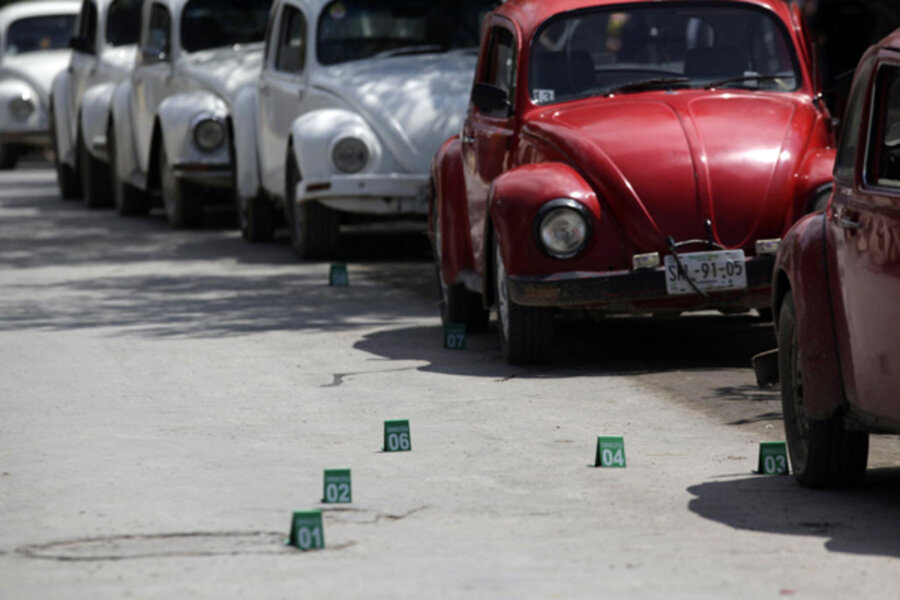8 taxi drivers killed in Mexico: why are they targeted by cartels?
Loading...
• A version of this post ran on the author's site, Insightcrime.com. The views expressed are the author's own.
The murder of eight taxi drivers in a Monterrey suburb appears to be the latest assault by organized criminal groups against transport workers in Mexico, with the Zetas fingered as the killers.
The drivers were killed by a group of gunmen in two attacks on taxi service stations in Guadalupe, Nuevo Leon, on Tuesday afternoon. Two others, including a minor, were injured in the attacks. Local and federal authorities mobilized in response to the killings, but no suspects have been located so far. The two shootings occurred roughly 6 miles from one another, in a marginal section of Guadalupe that relies on pirate taxis to connect residents to the city center.
Long considered to be among Mexico’s safest and most cosmopolitan cities, Monterrey and the surrounding region has turned into one of its most notoriously violent over the past two years. In 2010, the number of murders leaped to 828 across Nuevo Leon, up from 267 the previous year. The figure jumped once more in 2011, to a total of 2,003. While much of Mexico has grown more violent in recent years, Monterrey’s status as Mexico’s industrial capital, its third largest city, and home to some of its wealthiest neighborhoods made its decline particularly alarming.
The violence has been driven by a split between two powerful former allies, the Zetas and the Gulf Cartel, who operate in the region. The fight originally began in Tamaulipas, which borders Nuevo Leon, after the Gulf assassinated a Zetas boss and refused to hand over the perpetrators. The battle spread across Mexico’s northeast, and Monterrey has been the site of some of the most notorious acts of violence in recent years.
Perhaps the most infamous incident was the murder of 52 casino patrons in August 2010, the result of a fire set by the Zetas as punishment for an unpaid extortion fee. It was the most deadly single attack in recent Mexican history. The outcry over the mass murder was heightened by the emergence of a video showing the brother of Monterrey Mayor Fernando Larrazabal apparently collecting an extortion payment from a Monterrey casino.
It remains unclear precisely why the taxi drivers were targeted, but initial reports fingered the Zetas. The group has steadily encroached upon a growing list of illicit activities, from pirate merchandising to oil theft. It would not be out of character for the Zetas to move into the pirate taxi racket as well, which could provoke violent incidents like the Guadalupe attacks.
Taxis also often serve as "halcones" or lookouts for criminal groups, warning of police deployments and guarding against other groups making inroads into a given city. If the pirate taxis were working for a criminal group, they would be targets for retribution from rival gangs. Some reports, citing anonymous police sources, alleged that the murdered men worked as lookouts for the Zetas (in Spanish).
Taxis also frequently serve to facilitate retail drug sales, and another explanation links the killings to a taxi driver who was recently fired after being caught with drugs (in Spanish). According to this version, based on testimony from a surviving taxi driver, the fired employee threatened his co-workers with vengeance from the Zetas.
Whatever the motive for the crime, it is not the first time that transport workers have been targeted by organized crime groups in Mexico; indeed, this has grown increasingly common. The same day as the Guadalupe killings, five taxi drivers were killed in the southern resort city of Acapulco. In February, five Monterrey taxi drivers were gunned down as they chatted while waiting for fares outside of a furniture store. Last year, scores of taxi drivers were murdered in Acapulco, with organized crime groups presumed to be responsible (links in Spanish).
Buses have also been targeted. Last year, for instance, two buses in Juarez were burned after their owners refused demands from extortionists (in Spanish). The long-distance bus system has been linked to some of the most brutal incidents of the previous year: most of the hundreds of bodies found in mass graves in San Fernando, Tamaulipas, last spring had been passengers on buses passing through the region.
– Patrick Corcoran is a writer for Insight – Organized Crime in the Americas, which provides research, analysis, and investigation of the criminal world throughout the region.. Find all of his research here.
Get daily or weekly updates from CSMonitor.com delivered to your inbox. Sign up today.





